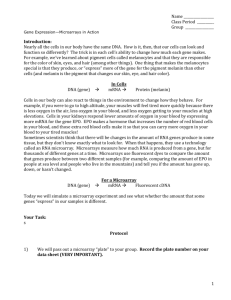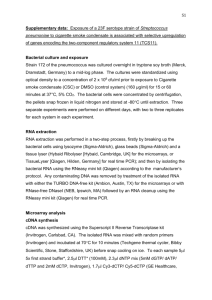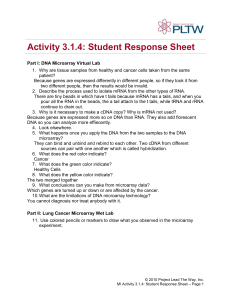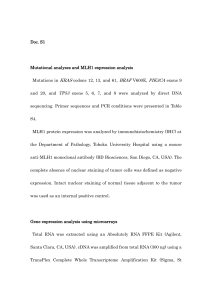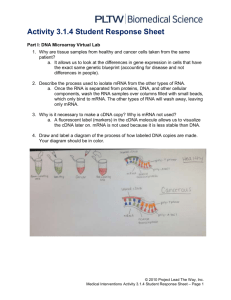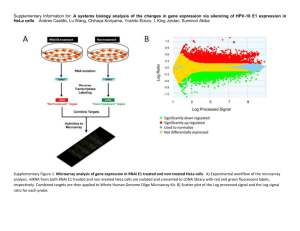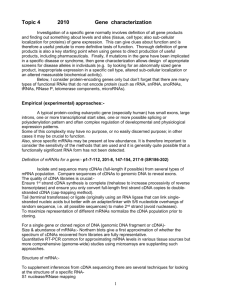Let`s Make Your DNA Microarray Results
advertisement
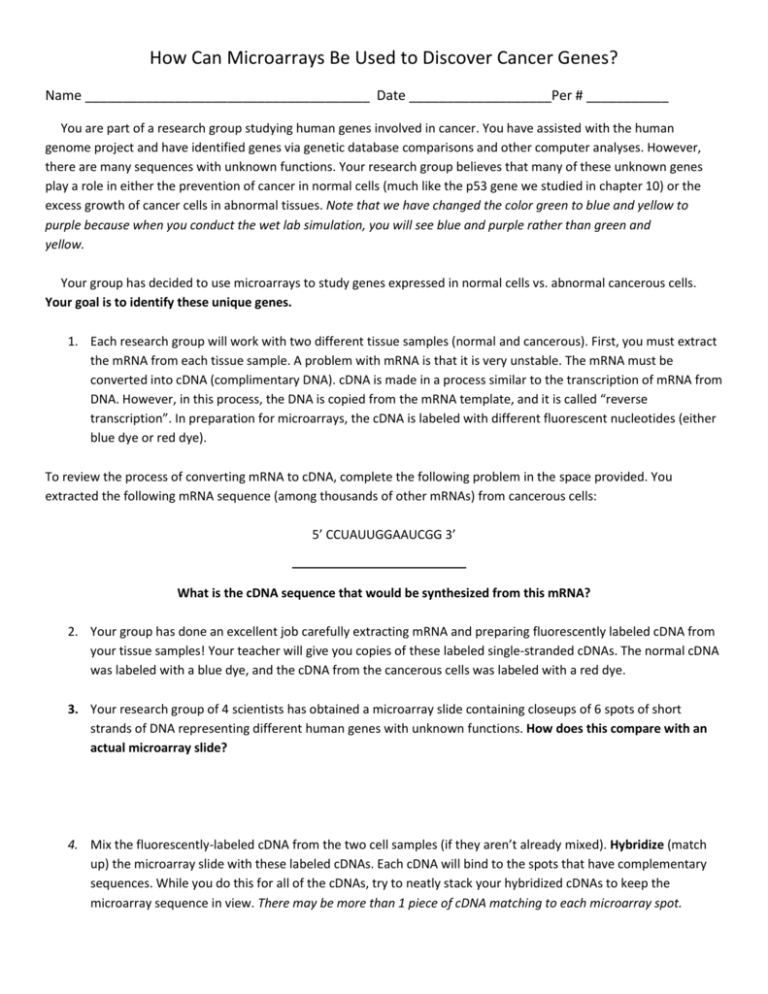
How Can Microarrays Be Used to Discover Cancer Genes? Name ______________________________________ Date ___________________Per # ___________ You are part of a research group studying human genes involved in cancer. You have assisted with the human genome project and have identified genes via genetic database comparisons and other computer analyses. However, there are many sequences with unknown functions. Your research group believes that many of these unknown genes play a role in either the prevention of cancer in normal cells (much like the p53 gene we studied in chapter 10) or the excess growth of cancer cells in abnormal tissues. Note that we have changed the color green to blue and yellow to purple because when you conduct the wet lab simulation, you will see blue and purple rather than green and yellow. Your group has decided to use microarrays to study genes expressed in normal cells vs. abnormal cancerous cells. Your goal is to identify these unique genes. 1. Each research group will work with two different tissue samples (normal and cancerous). First, you must extract the mRNA from each tissue sample. A problem with mRNA is that it is very unstable. The mRNA must be converted into cDNA (complimentary DNA). cDNA is made in a process similar to the transcription of mRNA from DNA. However, in this process, the DNA is copied from the mRNA template, and it is called “reverse transcription”. In preparation for microarrays, the cDNA is labeled with different fluorescent nucleotides (either blue dye or red dye). To review the process of converting mRNA to cDNA, complete the following problem in the space provided. You extracted the following mRNA sequence (among thousands of other mRNAs) from cancerous cells: 5’ CCUAUUGGAAUCGG 3’ What is the cDNA sequence that would be synthesized from this mRNA? 2. Your group has done an excellent job carefully extracting mRNA and preparing fluorescently labeled cDNA from your tissue samples! Your teacher will give you copies of these labeled single-stranded cDNAs. The normal cDNA was labeled with a blue dye, and the cDNA from the cancerous cells was labeled with a red dye. 3. Your research group of 4 scientists has obtained a microarray slide containing closeups of 6 spots of short strands of DNA representing different human genes with unknown functions. How does this compare with an actual microarray slide? 4. Mix the fluorescently-labeled cDNA from the two cell samples (if they aren’t already mixed). Hybridize (match up) the microarray slide with these labeled cDNAs. Each cDNA will bind to the spots that have complementary sequences. While you do this for all of the cDNAs, try to neatly stack your hybridized cDNAs to keep the microarray sequence in view. There may be more than 1 piece of cDNA matching to each microarray spot. 5. Wash the slide to remove excess fluorescent cDNA not bound to spots. (You may simply remove the unbound cDNAs and put them back in your envelope.) 6. Read the microarray using an instrument that measures the fluorescence of each spot at two different wavelengths for blue or red. On the blank microarray slide below, use markers or colored pencils to color each spot. 1 2 3 4 5 6 7. Analyze the data to determine which genes (represented by spots on the slide page) are expressed in each tissue sample (and which are expressed in both). What does each color represent about the expression of the gene? blue = _______________________________________________________ red = ________________________________________________________ purple = _____________________________________________________ 8. Your group has obtained interesting results that may be useful in determining how cancer cells differ from normal cells! The next step in genomics studies is to further study those genes that appear to be important in your treated cells. Which unknown gene sequences (#1-6) appear to be genes used in all cells? ____________________________________ Which unknown gene sequences (#1-6) might be cancer-preventing genes? ____________________________________ Which unknown gene sequences (#1-6) might be genes that cause cells to become cancerous? _____________________ Are all of the genes expressed at the same level? How do you know this? What could this mean? What additional questions do you have regarding your microarray results? Let’s Make Your DNA Microarray Results “Quantitative” In a real laboratory situation, lasers excite the fluorescent labels (dyes) attached to the cDNA’s which are hybridized to gene segments on a DNA microarray. A computer stores this information, then uses an algorithm to assign a “value” to each spot, considering the intensity of the fluorescent signals (including a combination of the two dyes). Scientists then interpret the data, looking for genes that are expressed differently between the “control” cells and the “experimental cells”. Here, we will assign a value of +1 for each tumor cell (red) cDNA that hybridized to a gene; we will give a value of –1 to every normal cell cDNA (blue) that hybridized to a gene. We will then add the values and observe which genes are expressed differently between the control and cancerous cells. Gene # #Normal cDNA's;Value # Tumor cDNA's; Value Sum of Values, columns 2 + 3 1 2 3 4 5 6 Genes of Interest: A gene with a final value of “0” is not of interest, because it is equally expressed in both the cancer cells and normal cells (gene #_______), or is expressed in neither cell type (gene #_____). Any gene that does not have a final value of zero is of potential interest. If a value is positive, it means that the gene is expressed more strongly in a cancer cell. (in the case of gene #_______), it is not expressed at all in the normal cells but is expressed highly in a cancer cell. If a final value is negative, it means that the expression of that gene is reduced or suppressed in a cancer cell as compared to the normal cell (genes #_____, #_____ and #_____). Which genes should your group of scientists study further? ________________________________________________ What do you think scientists/geneticists might be able to do with the genes in their studies that would help humanity? Adapted from ©2004 Carolyn A. Zanta, UIUC-HHMI Biotechnology Education and Outreach Program (BEOP) www.life.uiuc.edu/hughes/footlocker

